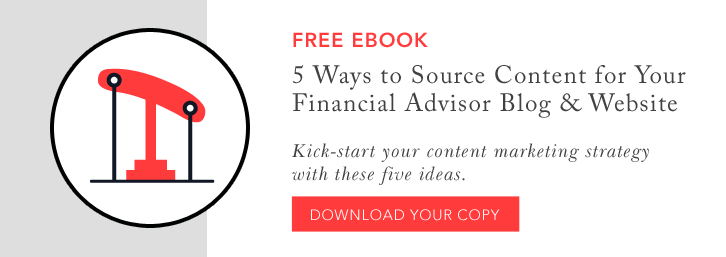

Social Media Tips for Financial Advisors
Social media is becoming a valuable communication channel for personal and commercial use alike. But how do you get started? And once you’re started, how do you keep your audience engaged and grow your social media presence? These can be overwhelming questions, and could even be enough to deter some financial advisors from having any social media presence at all. Before you get overwhelmed, here are some easy tips for starting and maintaining your social media presence:
Getting Started
Before diving straight into social media, you need to decide how much time and resources you’re able to commit to maintaining your presence. For example, if you’re a one-person operation with no support staff, you probably want to start out small and focus on 1-2 social media channels at first. There are many social media platforms, with more popping up almost daily, but the current leading social sites with commercial value are: Facebook, Twitter, LinkedIn, and YouTube.
- Facebook currently has 2.01 billion monthly active users and 65 million business pages. The format for Facebook is on the “page” where businesses can share content such as photos and videos, hold contests, get reviews from customers, answer and ask questions, and much more. There is also a messaging platform available for p2p conversations that are not displayed on the page. Facebook accounts are free, and businesses can also utilize paid advertising to reach specific audiences, not just followers of the business page.
- Twitter is a messaging platform with around 330 million users that limits content to 140 characters. Known as “tweets,” this content can contain links to photos, videos, and other content on the web. Twitter accounts are free, and businesses can pay for sponsored tweets to enhance the visibility of a specific message.
- LinkedIn is a business-focused platform that encourages the sharing of business –focused content, celebrates users’ professional milestones, and encourages connections between its 106 million users. Businesses can list jobs, advertise their services, and post relevant content to their audience.
- YouTube is a video platform that is popular for everything from viral cat videos to financial advice and step-by-step tutorials for just about anything. While once considered only a place to watch videos, YouTube has secured its place as a bona fide social network with the viral nature of content that is shared by the millions on the above mentioned social media channels. In an average day, more than 5 billion videos are watched worldwide.
Creating fresh, relevant content for your website or blog can be a challenge. Say goodbye to writer's block! Download our Free eBook: 5 Ways to Source Content for Your Financial Advisor Blog & Website
Make a Plan
When choosing which channel(s) to begin with, determine what type of content you will be sharing and how much time you have to dedicate each day. Some social platforms move at a faster pace than others, such as Twitter and Facebook. These platforms are both essentially news feeds, and if you only share content once a week, your message will get lost. Plan on contributing at least daily on Facebook and at least 2-3 times a day on Twitter if you want to stay in the mix. For LinkedIn and YouTube, the information still needs to remain relevant but doesn’t require a daily contribution such as Facebook and Twitter. Also, the value of YouTube is that the videos can be shared on all other social media sites, enhancing their reach to all of your social media audiences.
If this all seems daunting, a good way to stay on track is to create a social media calendar in advance, considering certain times of the year when you’d like to share specific content. For example, if there are some year-end financial tips, you would plan on sharing that in December, and you may have some information that’s relevant in the summer and so on. Having a calendar planned in advance is a great way to ensure you keep up with the demands of social media and maintain a constant presence.
Just as important as posting content is sharing the content of other reliable resources such as news agencies and financial sites. This can establish you as a go-to resource for valuable information and can increase engagement and followers. And speaking of engagement, it’s important to remember that social media is a two-way communication channel. Many users will reach out on social platforms with comments and questions. It’s important to respond in a timely manner, even if the comment was a complaint. In that case, taking the comment offline is the best approach. This can be done via a private Facebook message, email, or phone call.
Know the Rules
As a financial advisor, you’re no stranger to rules and regulations. Social media is no exception. In fact, as an emerging and constantly evolving communication channel, the rules are constantly changing. Before getting started, it’s best to check the current regulations and stay on top of any changes to the rules. For the most current regulations, visit www.sec.gov.
Social media can be a great way to grow your client base, as well as grow your list of potential clients. While there is some work that needs to be done on the front end, such as establishing pages and creating a social media calendar, this can prove to be worth the effort in the long-run. Once you’re up and running with the basics of social media, you can grow your online presence further down the road.

Jack Waymire, BA, MBA
Search Here
Categories
- AI (18)
- blogging (2)
- branding (1)
- content (12)
- custodians (1)
- Digital (345)
- email marketing (3)
- fcmo (2)
- fees (1)
- financial advisor marketing (62)
- Google (3)
- Ideas & Tips (78)
- Investor Experience (7)
- lead generation (7)
- linkedin (1)
- Marketing (371)
- newsletters (1)
- Online Transparency (2)
- search engine optimization (3)
- seo (9)
- Social Media (2)
- video (2)
- Websites (108)
- YouTube channel (2)
Recent Posts
-

-

How Financial Advisor Blogging Generates Thought Leadership and Leads
November 24, 2025 -

Top 5 Ways Digital Marketing Benefits Financial Advisors Seeking Leads
November 20, 2025 -

Trust Is The Biggest Online Marketing Challenge For Financial Advisors
November 17, 2025 -

Compliant Financial Advisor Bios Using AI Website Builders
October 22, 2025

